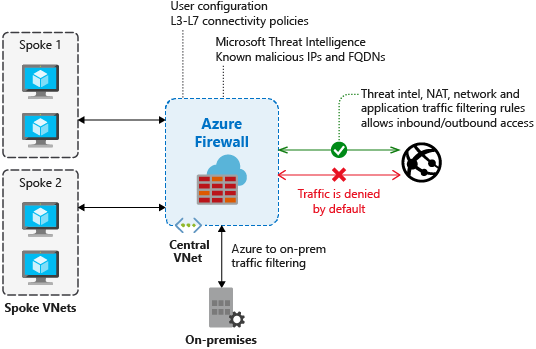Microsoft Azure Firewall
Microsoft Azure Firewall
Introduction
- Azure Firewall is a managed, cloud-based network security service provided by Microsoft Azure.
- It offers comprehensive, centralized network and application-level protection to safeguard your Azure Virtual Network resources.
Key Features of Azure Firewall
Stateful Firewall:- Azure Firewall is a stateful firewall, meaning it tracks the state of active connections and makes decisions based on the context of the traffic.
Built-in High Availability:- The service is inherently designed for high availability with built-in failover capabilities, ensuring continuous protection.
Scalability:- Azure Firewall automatically scales with your network traffic, providing consistent protection without manual intervention.
Network and Application Rules:- Network Rules: Control inbound and outbound network traffic based on source and destination IP address, port, and protocol.
- Application Rules:** Control outbound HTTP/S traffic by defining fully qualified domain names (FQDNs) or URL-based rules.
Threat Intelligence:- Azure Firewall can be configured to alert or deny traffic from/to known malicious IP addresses and domains using Microsoft’s threat intelligence feed.
Logging and Analytics:- Logs all traffic and can be integrated with Azure Monitor, Azure Sentinel, or third-party SIEM (Security Information and Event Management) solutions for detailed analysis and monitoring.
Integration with Other Azure Services:- Easily integrates with Azure Virtual Network, Azure Application Gateway, Azure VPN Gateway, and other Azure services.
NAT (Network Address Translation) rules
- NAT rules in Azure Firewall allow you to configure how traffic is translated as it passes through the firewall. = These rules are essential for managing inbound and outbound traffic and enabling secure and efficient communication between your internal network and external networks.
Types of NAT Rules
Inbound NAT Rules:- Used to translate and route incoming traffic from an external source (e.g., the internet) to a private IP address within your Azure Virtual Network.
- Commonly used for scenarios where external users need to access services hosted within your virtual network, such as web servers or other applications.
Outbound NAT Rules:- Used to translate and route outgoing traffic from a private IP address within your virtual network to an external destination (e.g., the internet).
- Ensures that traffic from your internal resources appears to come from a single public IP address or a pool of public IP addresses.
Key Benefits
- Enhanced Security:
- Provides robust protection for your Azure Virtual Network with both network and application-level filtering.
- Simplified Management:
- As a managed service, Azure Firewall simplifies network security management, removing the need to deploy, scale, or maintain firewall appliances.
- Consistent Policy Enforcement:
- Centralizes network security policy enforcement across multiple subscriptions and virtual networks.
- Cost Efficiency:
- Reduces the need for separate firewall appliances, potentially lowering overall costs while benefiting from Azure’s scalability.
Use Cases
Perimeter Network Protection:- Acts as a barrier between your Azure Virtual Network and the internet or other external networks, controlling traffic flow and protecting against external threats.
East-West Traffic Filtering:- Inspects and filters internal traffic between subnets and virtual networks, preventing lateral movement of threats within your environment.
Application Protection:- Protects your applications by controlling outbound traffic and preventing access to malicious domains.
Routing Traffic through Firewall
- By setting up a route table with a UDR and associating it with your VM’s subnet, you can ensure that all traffic from the VM is routed through Azure Firewall.
- This setup enhances security by allowing Azure Firewall to inspect and control the traffic, providing centralized management of network security policies.
- Steps:
- Set Up Azure Firewall
- a. Deploy Azure Firewall
- b. Create a Public IP for Azure Firewall
- c. Associate the Public IP with the Firewall
- Create an Azure Route Table
- a. Create a Route Table
- b. Create a Route in the Route Table
- Associate the Route Table with the Subnet
- Configure Network Security Groups (NSGs)
- a. Allow Traffic to and from Azure Firewall
- Verify and Test the setup
- Set Up Azure Firewall
Application Rules in Azure Firewall
- Azure Firewall’s application rules provide a powerful mechanism for controlling outbound traffic based on URLs and FQDNs.
- By defining granular access policies, you can enforce security measures, comply with regulatory requirements, optimize network traffic, and gain visibility into application-level traffic patterns within your Azure Virtual Network.
This post is licensed under CC BY 4.0 by the author.
